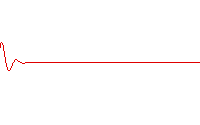Non-linear differential equations come in many forms. One of these forms is separable equations. A differential equation that is separable will have several properties which can be exploited to find a solution.
A separable equation is a differential equation of the following form:
The original equation is separable if this differential equation can be expressed as:
where
where
To separate the equations means to move all the
A general approach to solving separable equations is as follows:
- Multiply and divide to get rid of any fractions.
- Combine any terms involving the same differential into one term.
- Integrate each component on its own, and don't forget to add constants to equations after integrating. This ensures that the solution is of the general form.
- Finally, simplify the expression (i.e., combine all possible terms, rewrite any logarithmic terms in exponent form, and express any arbitrary constants in the most simple terms possible).
After simplifying you will have the general form of the equation. A particular solution to the equation will depend on the choice of the arbitrary constants you obtained when integrating.
For example, consider the time-independent Schrödinger equation :
If the function
then it turns out that the problem can be separated into three one-dimensional ordinary differential equations for functions:
The final solution can be written as follows:

Non-Relativistic Schrödinger Equation
A wave function which satisfies the non-relativistic Schrödinger equation with